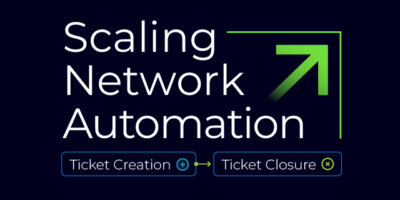Network performance and reliability are the foundations of modern enterprise operations. Global business relies on billions of devices connected to IP networks exchanging exabytes (translation: a lot) of data. Not to mention, global operations are becoming more important to business goals, and more data needs to be streamed over networking infrastructure even as low latency demands become louder. In this evolving landscape, manual infrastructure management is no longer a viable option. Organizations are turning to network automation to adapt to new traffic patterns, eliminate network downtime, and assure quality for key services.
Adapting to New Traffic Patterns
As organizations continue to adopt cloud infrastructure, development platforms, and more advanced networking software, they are expanding their set of digital offerings that all ultimately depend on network reliability and optimization. Without properly managing data center traffic, control of these services can become overwhelming and lead to widespread organizational challenges. This year, we’ve seen the solidification of the hybrid, work-from-anywhere model, and the business world understands that it’s here to stay. The hybrid model means network traffic is becoming increasingly complex, especially when considering zero-trust, SASE, and other hybrid security solutions that are becoming top priorities. Only through end-to-end network visibility supported by an automated solution that integrates with the full ecosystem can these systems be properly managed.
Eliminating Network Downtime
Human error is one of the biggest factors that results in network downtime. According to Cisco in 2020, “95% of network changes are done manually.” We would hope that number is lower today, but it’s definitely not as low as we’d like to see. Manual configuration of physical and virtual devices is error-prone, and with the number of devices that need to be managed only going up, it is no longer a reasonable path. By moving from manual configuration processes to automated processes, you can significantly enhance network consistency and uptime. The right automation solution can even help detect anomalies without the need for human intervention, eliminating network downtime.
Assuring Quality while Maintaining Operational Continuity
The past few years have presented some unique challenges, and even now, the changes the pandemic brought to the working world are apparent. In many ways, these transformations will be permanent, or at least will shape what things look like going forward—work-from-anywhere, a big increase in global network traffic, a doubtful financial climate, I could go on.
With all of this, organizations are more reliant than ever on consistent, available, and accurate data to make decisions and execute processes. An organization’s data must act as a source of truth when mitigating quality issues and manual errors. That means it’s critical to ensure network services remain operational and continue to produce the quality expected so data is always up to date and quickly accessible. Automations are only as good as an organization’s data, and therefore, companies need to aggregate and harmonize their data in order to enable a global view of resources. That will allow networking teams to automate change processes across more devices.
Companies that address these challenges now put themselves in a favorable position for further growth. Through network automation, organizations can successfully overcome significant challenges and increase the efficiency and effectiveness of their operations. Network automation’s true value is the way it supports this growth, making it more practical by enabling organizations to innovate at scale faster and for less money.
To learn more about today’s network management obstacles, the factors influencing network automation adoption, and how Itential is best positioned to help organizations succeed, download the MarketsandMarkets™ Network Automation Market – Global Forecast to 2025” report, naming Itential as “one of the leading providers of intelligent, multi-domain network automation software for both enterprises and service providers operating worldwide.”





